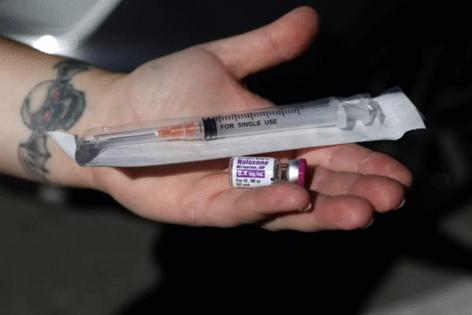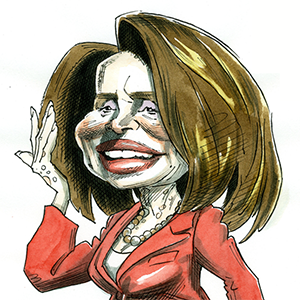Harm reduction techniques being phased out under Trump
Published in News & Features
WASHINGTON — The Trump administration is escalating its push against what has become a key part of the way states, localities and communities respond to the overdose epidemic: harm reduction.
A public health approach aimed at mitigating the negative health effects associated with drug use, harm reduction aims to prevent overdoses and infectious disease transmission.
Methods can involve the use of opioid overdose reversal medications such as naloxone, providing sterile needles to limit the transmission of infectious diseases, test strips that detect fentanyl in drugs, and “safe consumption sites,” where people can use drugs under supervision in case they need intervention.
In the past week, the administration began removing educational materials related to harm reduction from government websites.
President Donald Trump last month issued an executive order targeting homeless people, railing against “harm reduction” and “safe consumption” efforts.
And the Substance Abuse and Mental Health Services Administration told states last week that harm reduction is used to “advocate for policies that are incompatible with federal laws and inconsistent with this administration’s policies.”
Drug policy advocates say this pattern could cede ground on progress in reducing overdose deaths, particularly among people who are homeless.
“It’s deeply disturbing that we are moving backwards, and we’re finally in a time where the country is seeing rates decrease from overdose deaths,” said Carla Sofronski, executive director of the PA Harm Reduction Network, a Pennsylvania organization that advocates and provides education about harm reduction. “Now we’re pulling back from the same models that supported the decrease in deaths.”
At least 76,298 people died from drug overdoses in the 12-month period ending February 2025 — the lowest number since March 2020, according to preliminary Centers for Disease Control and Prevention data published in July.
The changes come at an already uncertain time for addiction policy advocates, after the administration in March clawed back $11 billion in funding that included addiction services funds, and with Congress facing multiple deadlines to maintain existing resources.
Lawmakers have until Sept. 30 to extend funds for the Community Health Center Fund and renew a pilot program for some Certified Community Behavioral Health Clinics. Despite the president’s order calling on both programs to support homeless individuals, lawmakers haven’t introduced legislation to renew either.
Additionally, portions of the wide-ranging 2018 bipartisan opioid law, known as the Support Act, have already lapsed.
Trump’s executive order alarmed harm reduction advocates by directing the Department of Health and Human Services to not fund “programs that fail to achieve adequate outcomes, including so-called ‘harm reduction’ or ‘safe consumption’ efforts that only facilitate illegal drug use and its attendant harm.” While not law, the order directs agencies to take regulatory action.
There are only a few safe consumption sites in the United States. Their goal is to limit the spread of infectious diseases and minimize lethal outcomes while serving as a bridge to connect users with other resources. Federal law already restricts federal funding of some harm reduction practices, including the cost of needles used at syringe exchanges.
But a shift in messaging from the government could have a chilling effect on state and local governments, which handle much of the U.S. opioid response.
“I think having messages like this come out of the White House makes it harder for people in communities to do this work, whether because of funding or because of what the public is hearing,” said Chrissie Juliano, executive director of the Big Cities Health Coalition, which represents urban local health departments.
The order didn’t specify which harm reduction methods the administration opposes, but a White House official told CQ Roll Call that the administration will continue to support, and even expand, access to naloxone, which reverses opioid overdoses. But the official said there was a line between naloxone and other harm reduction techniques, including syringe exchanges, which the administration says support illicit drug use.
Agency work
The Trump administration tried to dismantle SAMHSA, the agency focused on behavioral health grantmaking, and reorganize some of its programs under the new Administration for a Healthy America.
Those plans are on pause because of litigation, but in the meantime, SAMHSA has removed from its website a version of its overdose prevention toolkit that included sections on harm reduction and a separate “harm reduction framework” — both of which inform of emergency response measures.
In a “Dear Colleague” letter sent to states last week, Art Kleinschmidt, principal deputy assistant secretary at SAMHSA, said he doesn’t consider naloxone a harm reduction method and as such it would continue to be funded by the government. Kleinschmidt said test kits and other services can also be funded through grants.
But the letter stated that federal funding can’t be used to “purchase pipes or other supplies for safer smoking kits nor syringes or needles used to inject illicit drugs” or “any other supplies to promote or facilitate drug use.”
“Moving forward, SAMHSA funds will no longer be used to support poorly defined so-called “harm reduction” activities; rather, SAMHSA is providing guidance to state agency leadership and to grantees through new award terms and conditions that provide clarity on what supplies and services previously defined under the umbrella of harm reduction can be supported with SAMHSA funding,” Kleinschmidt wrote.
Senior officials during Trump’s first term showed a more nuanced take on harm reduction. Then-HHS Secretary Alex Azar supported syringe exchanges as a way to reduce the spread of infectious diseases like HIV. But the Justice Department during Trump’s first term threatened localities that were considering safe consumption sites for injectable drugs.
The Biden administration leaned in on harm reduction, releasing the first “harm reduction framework.”
Skepticism
Kleinschmidt, whom Trump picked as principal deputy assistant secretary at SAMHSA, has said that harm reduction approaches “are only exacerbating the problem” and that he would focus more on treatment than on reducing harm from drug use.
“There seems to be a great misunderstanding between enabling and helping,” Kleinschmidt said in a podcast last year.
“The more you’re sort of funding and feeding the addiction, you’re going to get more addiction. … They’re almost intentionally breeding dependency,” he said, referring to government employees working on addiction issues. “I sometimes have a hard time coming to any other conclusion.”
Mike Stuart, Trump’s pick for HHS general counsel, sponsored legislation during his time in the West Virginia state Senate that would restrict methadone clinics and ban syringe programs.
During Stuart’s nomination hearing Thursday, Sen. Maggie Hassan, D-N.H., noted that the measure “would have effectively ended the use of methadone to treat opioid addiction” in the state.
“I understand that there are bad actors in the methadone clinic space, to be sure, but do you think Secretary Kennedy is wrong to support medication-assisted treatment like methadone?” she asked.
Stuart replied that one of the bills targeted clinics that didn’t offer “wraparound” services such as counseling or health care.
The push away from harm reduction isn’t surprising. Several Republican lawmakers criticized a $30 million harm reduction grant program, funded through a 2021 COVID-19 relief law.
Then-Sen. Marco Rubio, R-Fla., pushed to include a ban on using federal funds to “distribute pipes or cylindrical objects intended to be used to smoke or inhale illegal scheduled substances” in the fiscal 2023 omnibus spending law.
©2025 CQ-Roll Call, Inc., All Rights Reserved. Visit cqrollcall.com. Distributed by Tribune Content Agency, LLC.







Comments